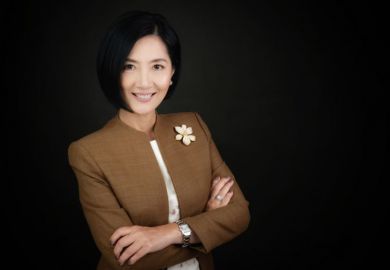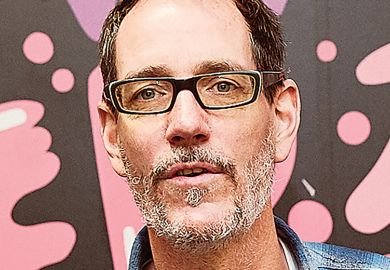Kate McMillan is a teaching fellow in culture, media and creative industries at King’s College London, where she teaches contemporary art and globalisation, and a practising artist. She studied for a BA in fine arts at Curtin University in Perth (1992-96), followed by a master’s (1997-99) and a PhD (2011-14). Her new immersive film-based installation exploring climate change and neglected female histories, The Lost Girl, can be seen at Bush House, King’s College London, until 28 February.
Where and when were you born?
Aldershot army hospital, Hampshire in 1974.
How did that shape who you are?
When I was 8, we moved to Perth, Australia. This defined my love for different experiences and cultures, but also a sense of constant dislocation. I feel like a citizen of the world and am suspicious of nationalism.
What sort of undergraduate were you?
I probably could have worked harder! But I had a lot of fun. I eventually pulled a rabbit out of the hat and got a first.
What were the initial themes you addressed as an artist?
At art school I was exploring my identity as a woman and there were a lot of vagina dentatas and autobiographical works. At the time, this was not supported at all – the general feeling was that it was self-indulgent. It took a long time to recover from this very masculine feedback and to feel confident in my intuition as an artist.
How can research enrich artistic practice (and vice versa)?
In my own work I accumulate a lot of material around a particular subject. It is not always clear how they interrelate, and sometimes it is not important to define that. All good research happens because we don’t know the answer to something. I see an artist in the studio very much like a scientist in the lab – experimenting and often finding unexpected outcomes. It is the openness of arts-based research that is exciting.
How have you explored climate change and the Anthropocene in your earlier work?
For a number of years, I have been thinking about the climate impacts of my work and trying to work more sustainably. This has meant moving more towards natural, non-polluting materials, performance and sound. However, I don’t see climate change in isolation. For me, it is a by-product of capitalism and colonialism. I have been working with the forgetting of colonial history in my work for almost two decades.
What led you to create the new installation?
In 2018, I had been struggling to justify making more “stuff” in the world. I wanted to think of a way to produce something meaningful that addressed the extreme outcome of capitalism and colonialism – loss. I spent more than a year gathering debris from the English Channel and the Mediterranean. There is a little bit of me in there too – I grew up on the beach near a cave not so different from [the one in The Lost Girl]. As a child I often imagined running away and living there. This girl is without language, she is alone with only her creativity to make sense of the world.
What are the pleasures and challenges of being forced to work within the constraints of a particular space?
Almost all my work is developed in response to a particular place, and this is no different with the Arcade at Bush House. Occasionally I get the opportunity to work in quite unusual spaces. Last year I filmed and presented a work in an old palace outside Berlin and for the Sydney Biennale I made a site-specific work in a timber drying shed on Cockatoo Island.
Why did you go back to a little-known work by D. H. Lawrence for the title and theme of your installation?
I had an old copy of this book sitting on my shelf for some time. I had initially just been drawn to the title of the book. But of course Lawrence is chronicling the life of a young girl as she tries to survive in a world determined by the fortunes and failures of the men around her. This seems very apt in today’s world.
What is the particular value of immersive works?
This is a strategy I have long used in my own work, to engender a feeling of being “in” the work, and to have the work move through your body. Perhaps [also] to leave a residue of it in the audience’s mind; people remember how something or someone made them feel, not just what they read or heard. In this sense, I hope my work stays with people and unfolds within them long after they have left the exhibition.
What do you see as the role of art in resurrecting neglected female and other marginalised histories?
I think women and First Nation cultures have always had the answers to some of the urgent crises of our time. However, there has been no space for their voices. In Australia we are witnessing extinction-level bushfires – Indigenous peoples have had the technology to prepare for this for tens of thousands of years, but they have been ignored.
What do you do for fun?
Read. In my fantasy, I am sitting in a beautiful Georgian house with piles of books around me and no deadlines. I also love to travel, but I have made a 12-month commitment to not fly anywhere, so I am finding places to travel to by train.
Do you live by any motto or philosophy?
Don’t do things that you need to keep secret, and treat others as you would like to be treated. I am also trying to never raise my voice, but I do have three teenagers so it’s tricky!
What one thing would improve your working week?
No marking!
matthew.reisz@timeshighereducation.com
Appointments
Anthony McClaran has been appointed vice-chancellor of St Mary’s University, Twickenham. Mr McClaran, currently chief executive of Australia’s Tertiary Education Quality and Standards Agency, will join the Catholic institution in April. He will succeed Francis Campbell, who is leaving St Mary’s at the end of this month to become vice-chancellor of the University of Notre Dame Australia. Previously Mr McClaran was chief executive of Ucas and the Quality Assurance Agency. The Rt Revd Richard Moth, chair of the board of governors at St Mary’s, said Mr McClaran “brings a wealth of experience of the UK and international higher education sectors that will benefit the university greatly”.
Catherine Harper is joining the University of the Creative Arts as deputy vice-chancellor. She has held the same post at the University of Chichester since 2016 and before that she was dean of the Faculty of Creative and Cultural Industries at the University of Portsmouth. A textiles expert, Professor Harper was a reader at UCA earlier in her career. She said she was looking forward to “bringing my personal commitment to the creative and cultural industries to this internationally respected academic community, and contributing to the significant and continued growth of UCA’s academic reputation, impact, and success”.
Lionel Green-Thompson has been named dean of the University of Cape Town’s Faculty of Health Sciences. He is currently dean of the School of Medicine at the Sefako Makgatho Health Sciences University.
Patricia Culligan has been appointed Matthew H. McCloskey dean of the College of Engineering at the University of Notre Dame. She is currently Carleton professor of civil engineering and engineering mechanics at Columbia University.
Former first minister of Wales, Carwyn Jones, is joining Aberystwyth University as professor of law on a part-time basis. He is a former barrister.
Register to continue
Why register?
- Registration is free and only takes a moment
- Once registered, you can read 3 articles a month
- Sign up for our newsletter
Subscribe
Or subscribe for unlimited access to:
- Unlimited access to news, views, insights & reviews
- Digital editions
- Digital access to THE’s university and college rankings analysis
Already registered or a current subscriber?




